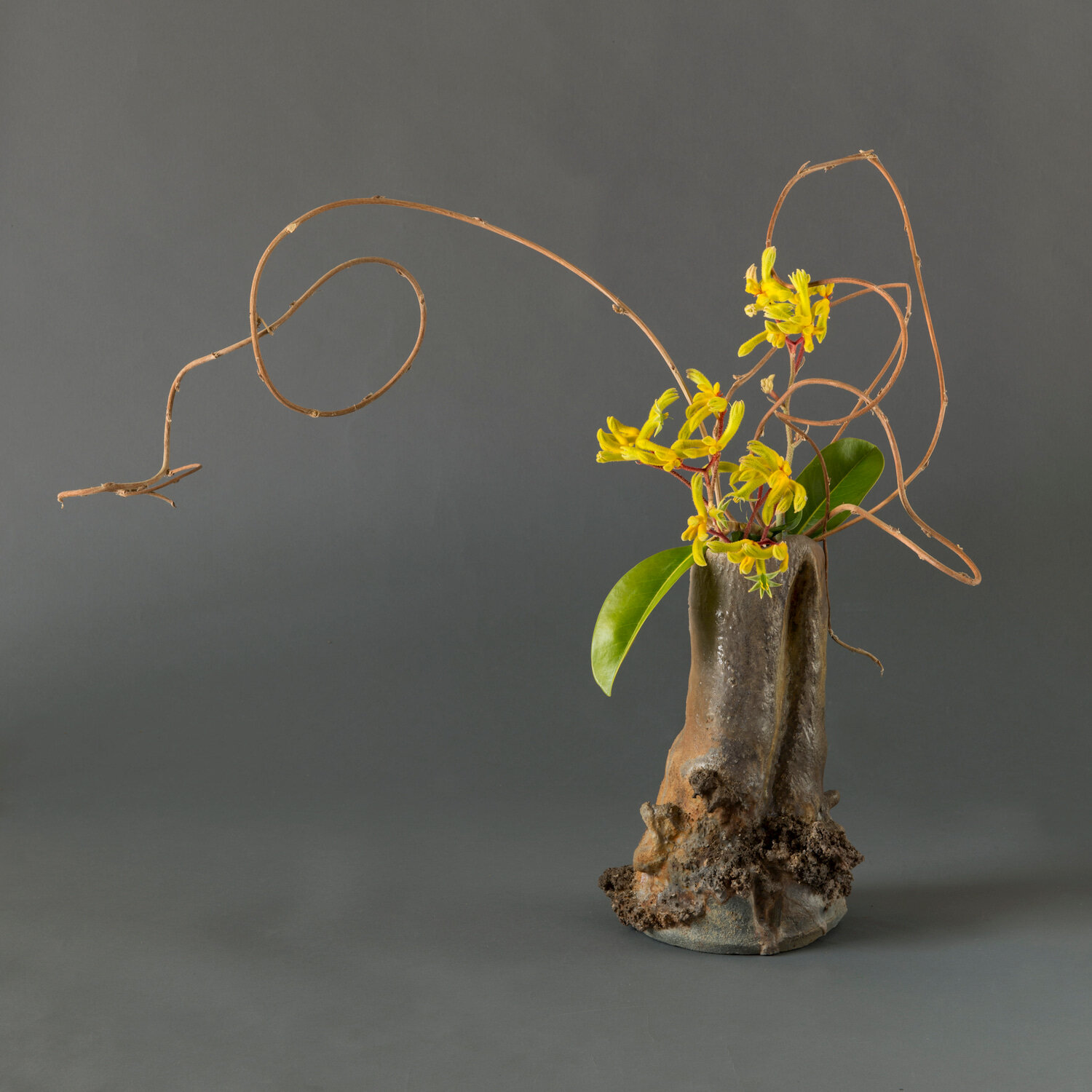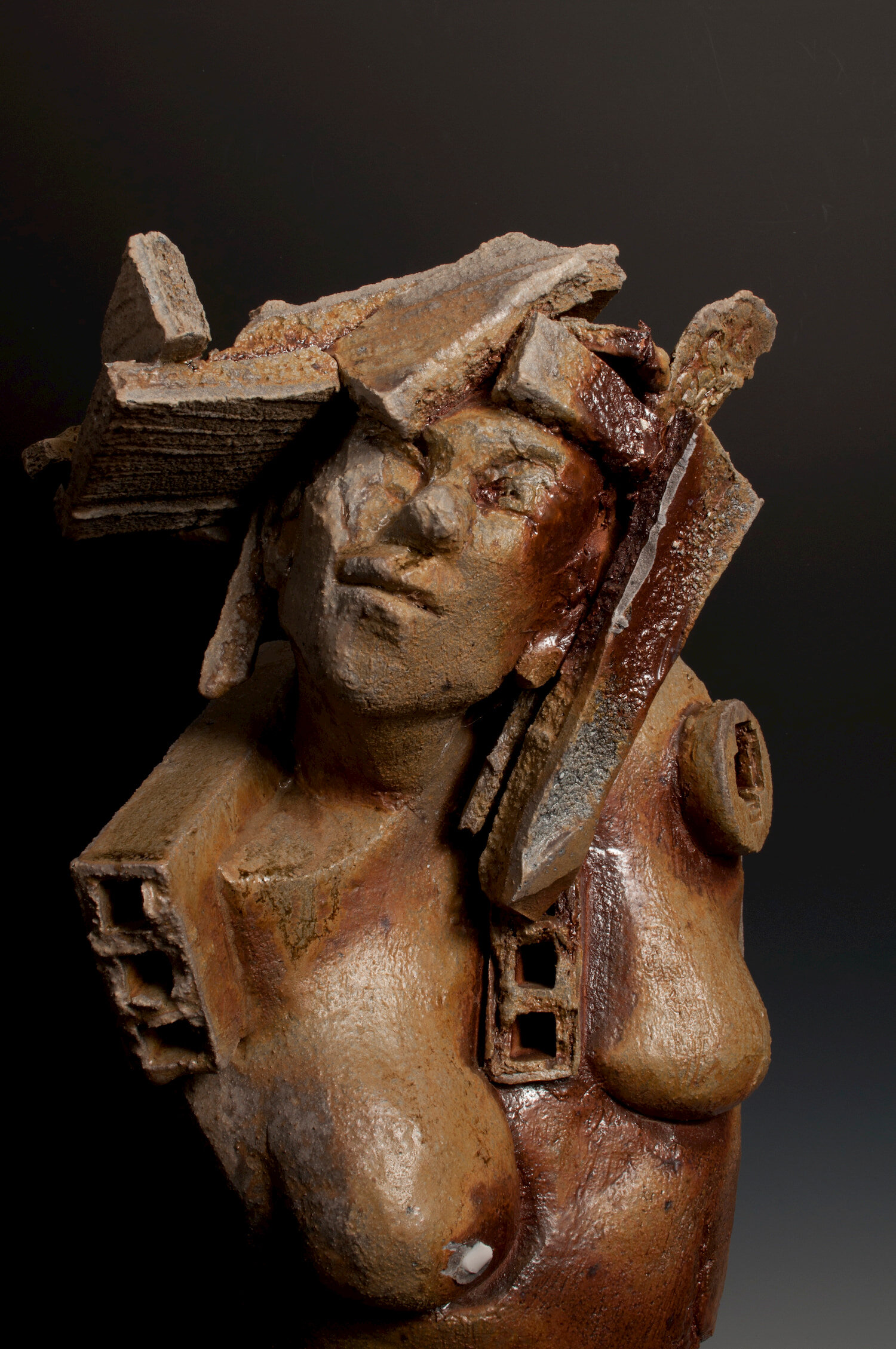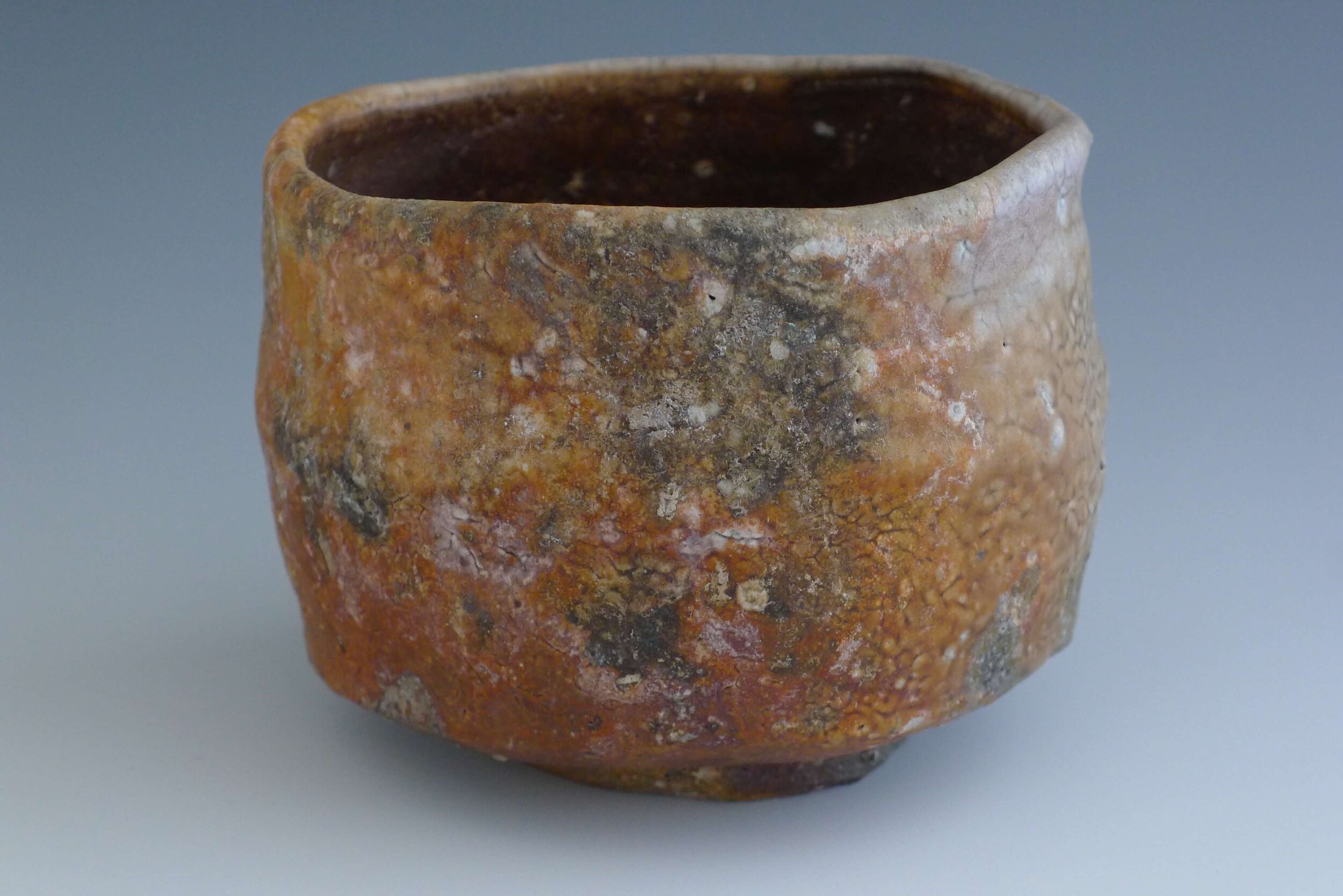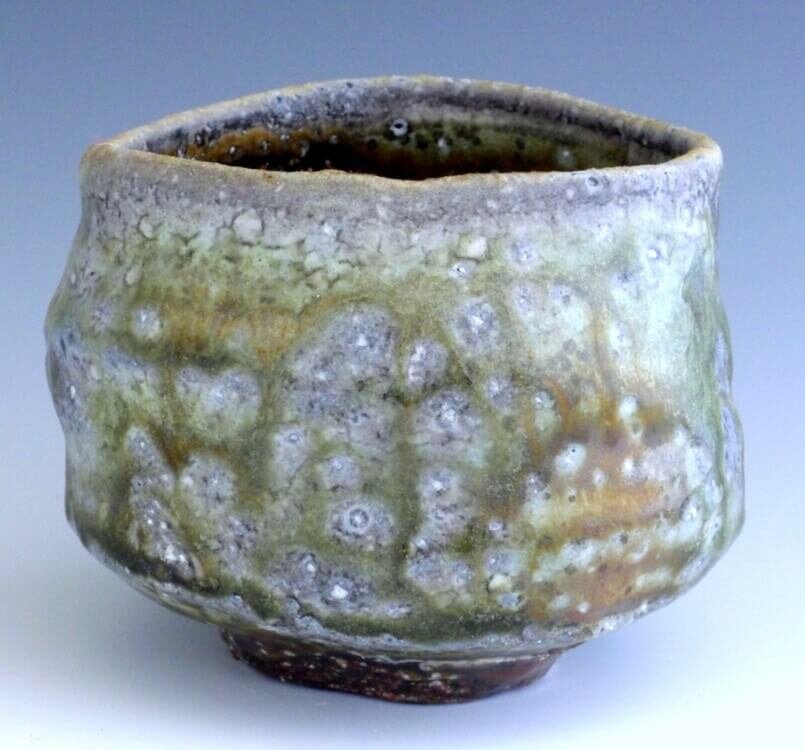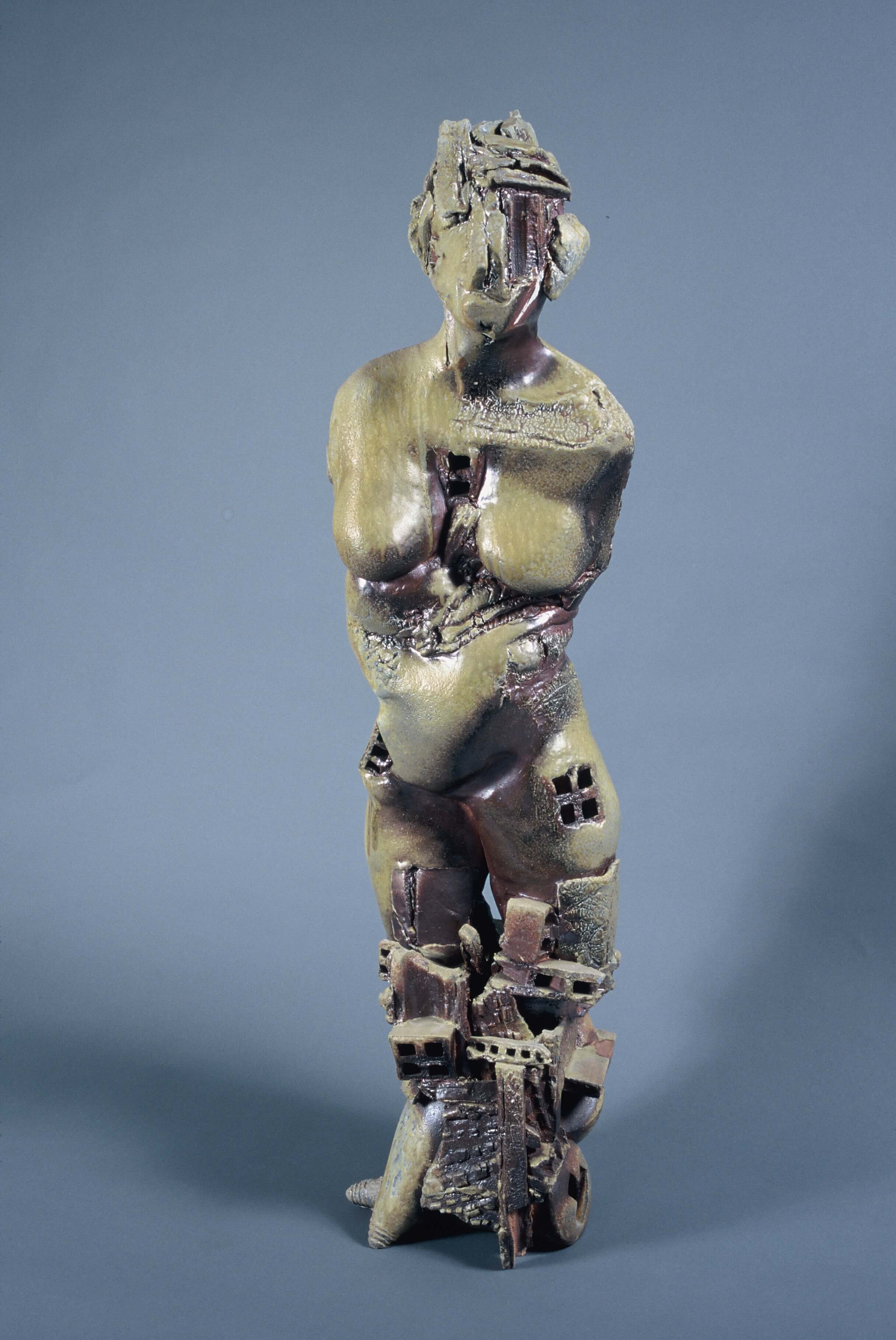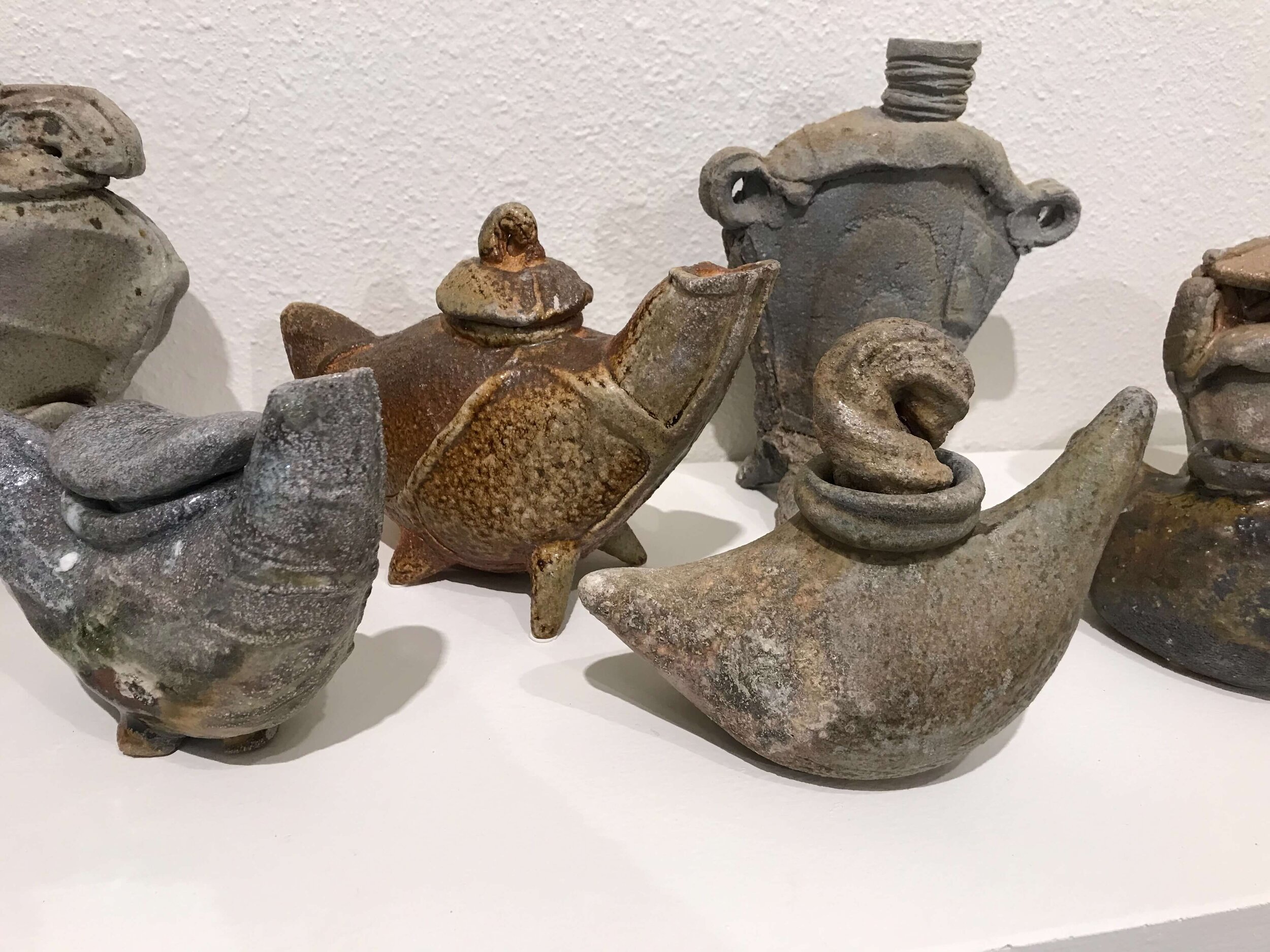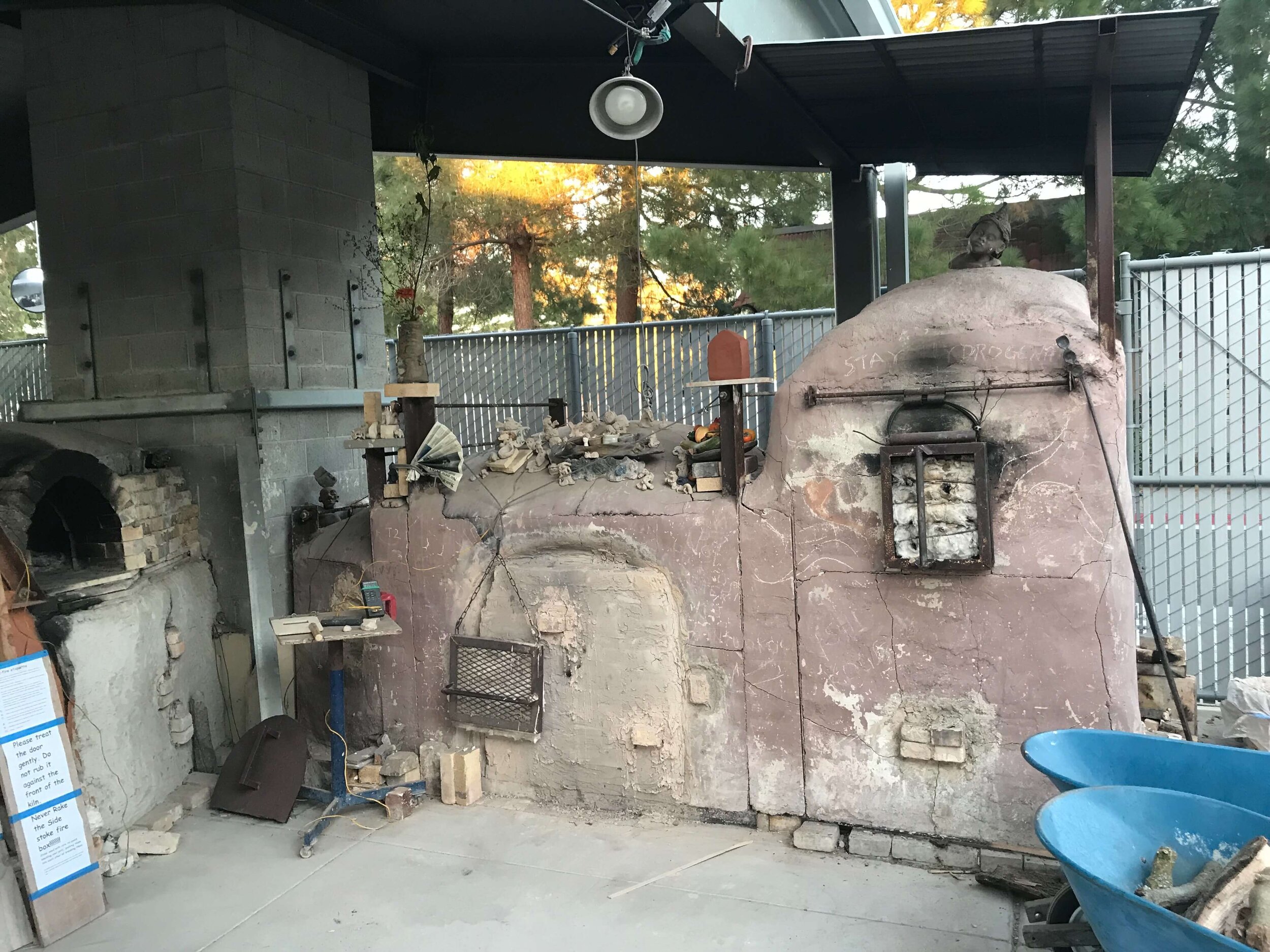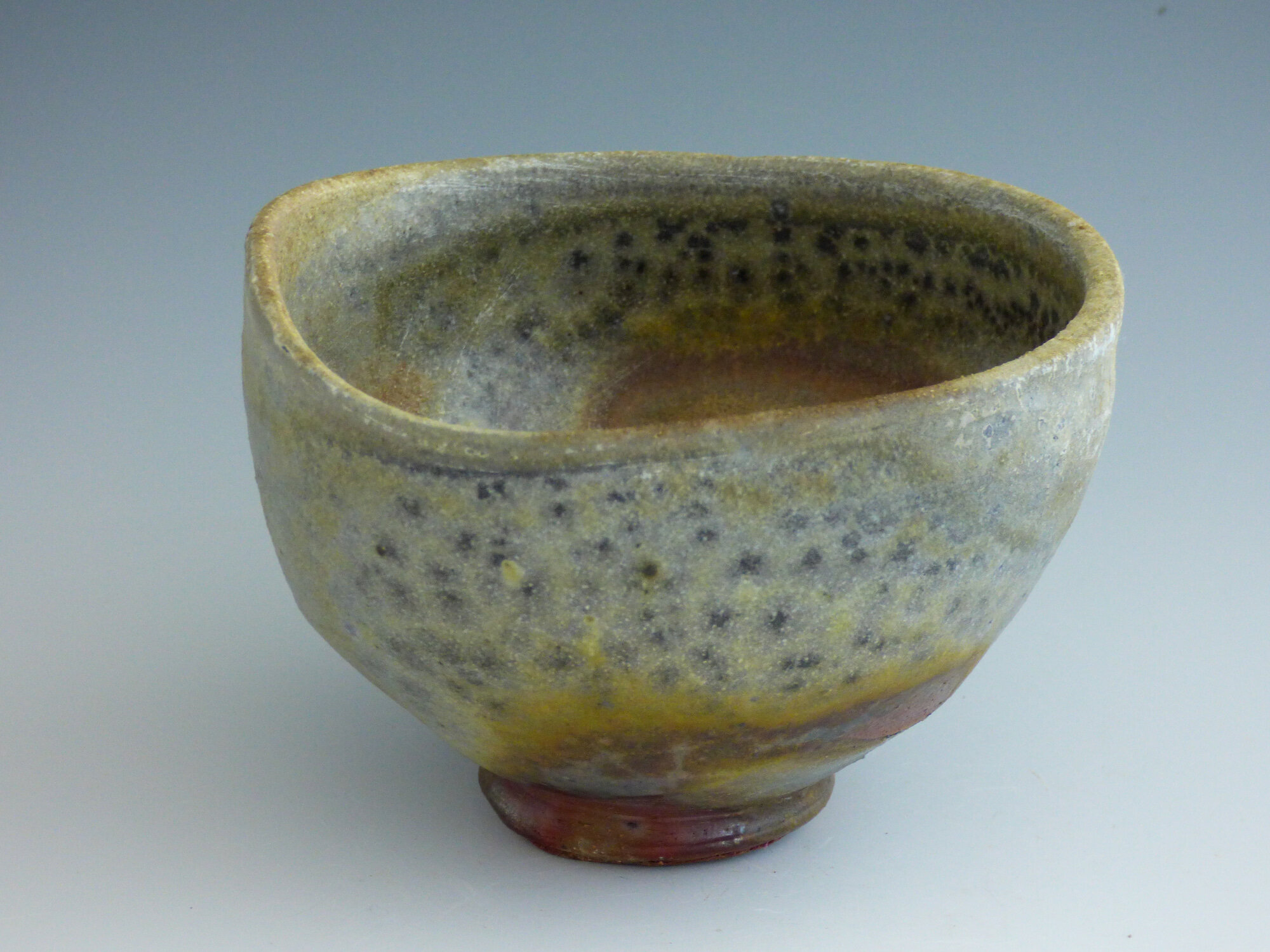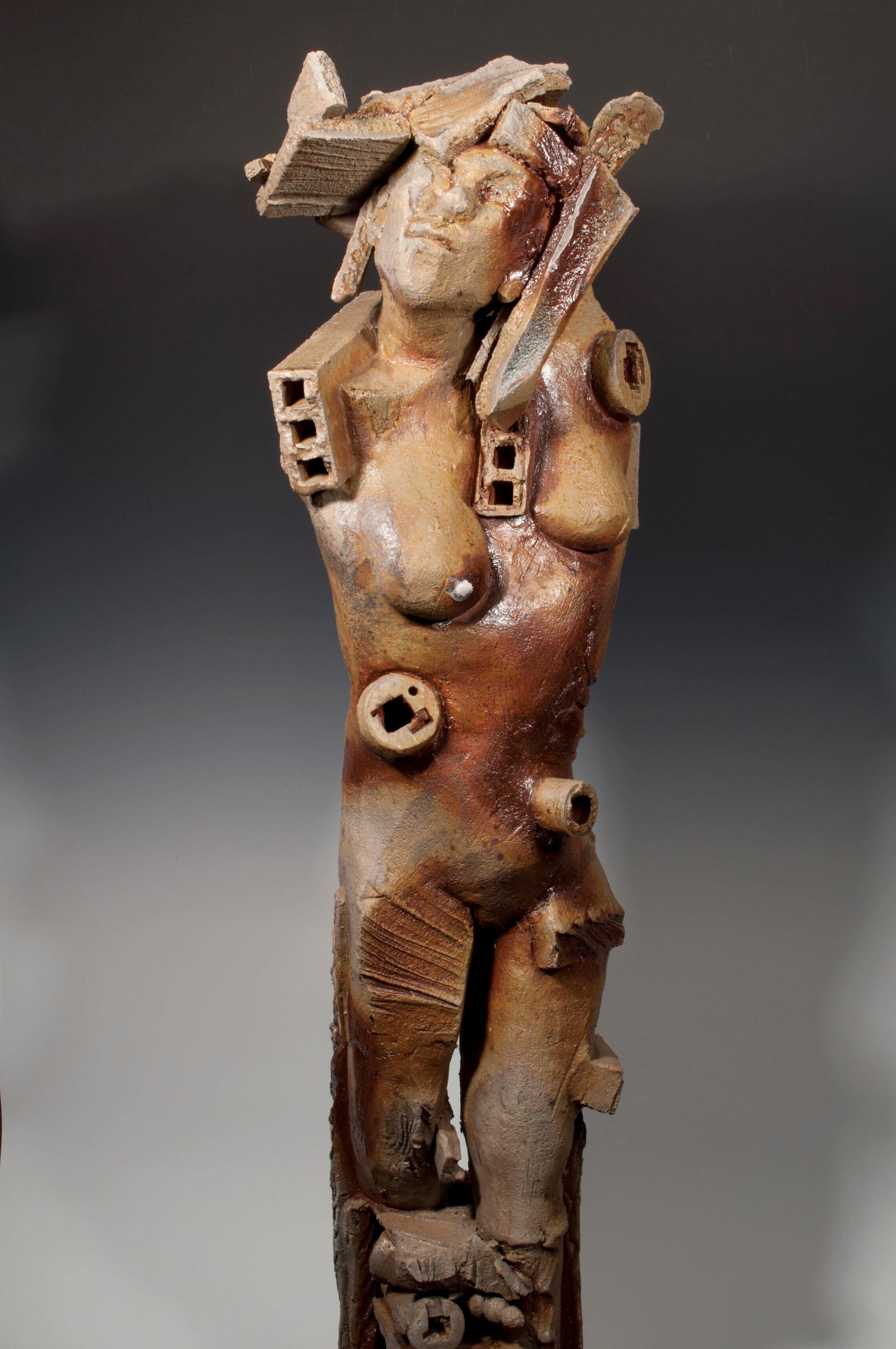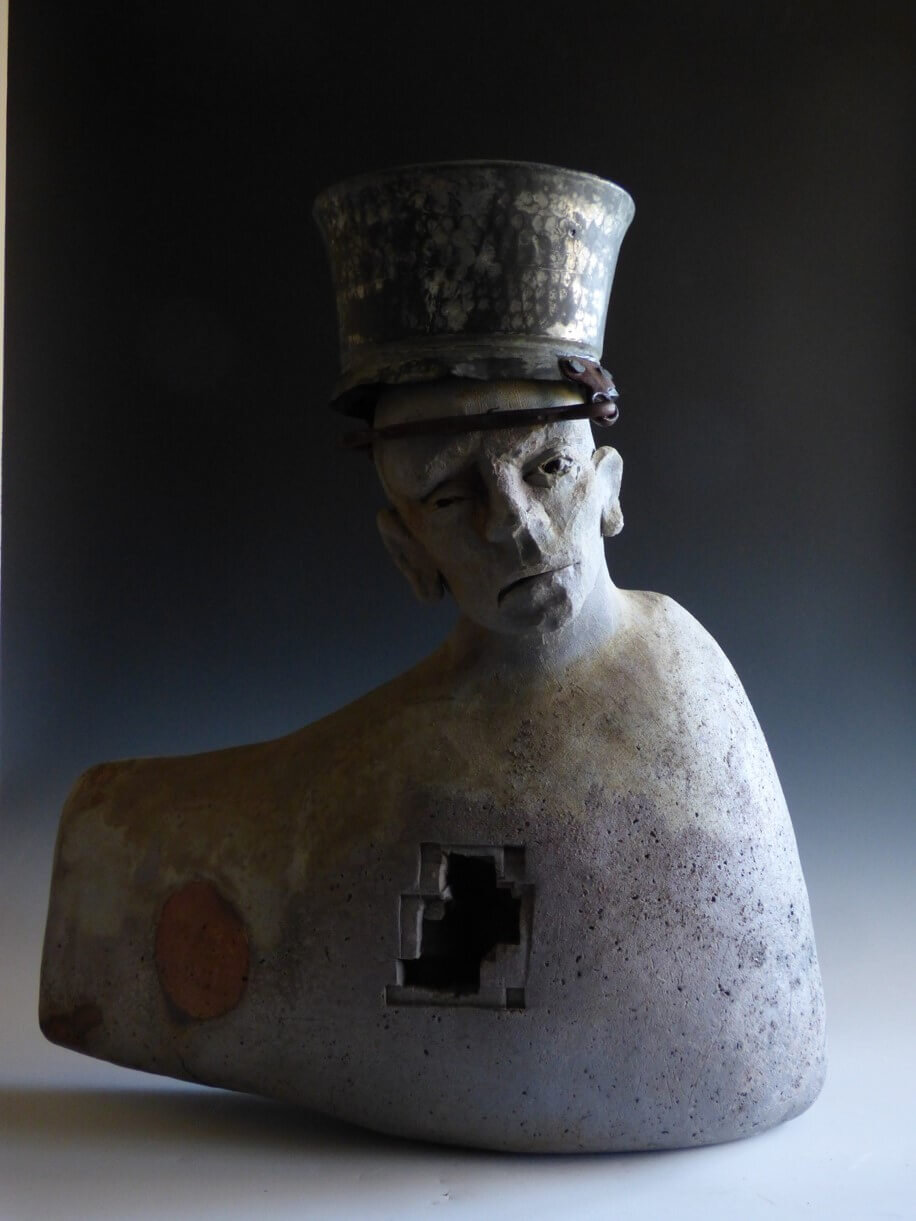The Allure of Wood Fired Ceramics by Marc Lancet
Poetry by Fire
How to explain beauty? In the presence of great beauty, our spirits transform. The view from a mountain ridge at dusk, basking in the light of a Vermeer painting, the dark tones of and craggy textures of an Iga vase, the endless tranquility of a temple garden, the desperately carved space of a Giacometti drawing, the speckled flame warmed volume of a Shigaraki storage jar, the flash of a darting rainbow trout, the red and purple tones of flame marking a Bizen vase, the soft glow of a coal fire in the tea house, the vast distances of a Rothko color field painting, the miracle of wood ash transformed by conflagration to a dark jewel green – these things can touch us; leaving us feeling more expansive; feeling a momentary rightness in the world. Take a wood-fired piece in your hands; can you follow the passage of this fire? Can you see where it eddied, repeatedly depositing ash in a scorching blizzard? Here where an unexpected blush of violet is met with a frosted orange crust? Or here, where colors undulate over an expanse of clay, textures transform – can you imagine the dance of the atmospheres? Oxygen, no oxygen, now a little, now more -- can you see it? And seeing it, can you feel the presence of beauty?
Wood-fire by Choice
Wood-fired ceramics must be stunningly beautiful, breathtakingly beautiful. It is the only explanation for its continued popularity. We can load an electric or gas kiln, start a computer-guided firing, and return a few days later to reap the results with much less effort than required when firing with wood. Why does an artist today elect the additional labor of gathering large quantities of wood, cutting it to size, staking it and seasoning it for a year, and then feeding the hungry mouth of the kiln every few minutes, twenty-four hours a day, for seven to fourteen days?
Wood-fire used to be the only means to fire clay. Today wood-fire is a choice. The effort required to wood-fire, once a necessity, now is voluntarily and enthusiastically preferred. With electric and gas kilns offering the ceramic artist almost effortless firing, why opt for seemingly unending days and nights of labor? Why in the face of modern convenience are ceramic artists internationally choosing to wood-fire? Only beauty offers an acceptable explanation. And not just beautiful, not just “oh that’s lovely,” casually noted beauty. It is an extraordinary beauty, a heart-achingly arresting beauty, a beauty of epic proportions, a beauty worth working for, a beauty only achievable by way of wood-firing. It can be no less. For what other goal would artists dedicate so much time and effort?
Wabi and Sabi: Walking In Beauty
It is no coincidence that wood firing has become so deeply rooted in Japan, developing subtlety and breadth of expression. Aesthetic principles, unique to Japan, wabi and sabi, honor a beauty common to nature. Wood-fired ceramics is an ideal match for these principles. As ideal as marble and fresco are matched to Western Renaissance architecture, wood-firing is a medium perfectly suited to express the beauty characterized by the concepts of wabi and sabi at the heart of the Japanese artistic Renaissance.
This is a beauty that is felt around the world but labeled in Japan. Wabi, and sabi are “tip of the iceberg” words; words whose meaning seems always to expand, remaining elusively out of reach of full comprehension, requiring devotional study for full understanding. Wabi and sabi are principles that are both aesthetic and spiritual. They cannot be understood only intellectually. They must be experienced. These two simple words still give birth to books to this day. Hundreds of pages are dedicated to an aesthetic, a philosophy, and a spiritual practice.
Horst Hammitzsch, in his remarkable Zen in the Art of the Tea Ceremony, portrays wabi and sabi:
Not only does this aesthetic ideal [sabi] embrace a mere simple beauty, but it has to be a beauty containing within itself the wabi feeling – a dark, subdued, yet pregnant beauty, the beauty of maturity. Sabi is characterized by the absence of obvious beauty, by the beauty of the colorless as opposed to the resplendent, by the beauty of the perishable as against the exuberantly active, by the beauty of a declining, yet wise, old age as against the beauty of an energetic yet immature youthfulness. The concept sabi, then, carries not only the meaning ‘aged’ – in the sense of ‘ripe with experience and insight’ as well as ‘ infused with the patina which lends old things their beauty’ – but also that of tranquility, aloneness, deep solitude.
Wabi is often described as the expression of these principles in action, a way of life or a spiritual path. Sabi is descriptive, referring to the presence of these qualities in objects. Hammitzsch sites the writings of Sen Sotan in a text called Zencharoku to illuminate the active aspect of wabi:
…once a person knows of wabi, no greed arises, no flouting of prohibitions, no unruliness, no negligence, no waywardness and no foolishness. From now on, greed is transformed into charity, the flouting of prohibitions into their strict observance, unruliness into forbearance, negligence into serious endeavor, waywardness into inner contemplation and foolishness into wisdom.
Loenard Koren, in his book Wabi-Sabi: For Artists, Designers, Poets & Philosophers, illuminates the overall aesthetic experience concluding:
The simplicity of wabi-sabi is probably best described as the state of grace arrived at by a sober, modest, heartfelt intelligence. The main strategy of this intelligence is the economy of means. Pare down to the essence, but don’t remove the poetry. Keep things clean and unencumbered, but don’t sterilize. (Things wabi-sabi are emotionally warm, never cold.) Usually, this implies a limited palette of materials. It also means keeping conspicuous features to a minimum. But it doesn’t mean removing the invisible connective tissue that somehow binds the elements into a meaningful whole. It also doesn’t mean in any way diminishing something’s “interestingness,” the quality that compels us to look at that something over and over and over again.
From these three citations alone, you can begin to understand the depth and complexity of the concepts of wabi and sabi. While intellectually intricate and profound, wabi and sabi are not obscure; they are common to modern art theory and practice. It is not the beauty that you find by reading lengthy explanations in contemporary art museums. Wabi and sabi are immediately accessible, and you have experienced them many times. When your heart warms to the beauty expressed in the first few wild-flowers of the season springing up in a field of green grass or in the subtle patterns of moss growing by the side of a small water flow, you are feeling the beauty of wabi and sabi. Full addiction to wabi and sabi is easily diagnosed when the “sufferer” is drawn to cast-off pieces of rusted metal and wood ravaged by wind and rain. It is an uncomplicated matter to experience an appreciation of wabi and sabi by just contemplating a piece of wood-fired ceramic art.
Surprise and the Endless Allure of the Elusive
Wood-fire artists reach for an elusive beauty. With experience, artists can confidently express their own vision with kiln, clay, form, and firing. And yet there is an intangible element. Connoisseurs and practitioners of wood-fired ceramics speak of the surprising, unpredictable quality of art from the wood kiln. Surprising like the sudden flash of color from the wings of a bird in flight, startling like a stone suddenly stunning when wet in the river’s water – wood-fired ceramic art seems both unexpected and inexplicably familiar. Natural ash glaze and flame markings adorn the work according to the logic of form and fire. Fire flows through the kiln as a river, the ceramic pieces are as stones that the fire negotiates passing from front to back. The resulting colors and textures are deposited according to natural forces. Moss grows on stones or trees according to different but equally complex natural influences. The resulting ceramic surfaces exhibit wide-ranging colors and textures arranged according to the intricate reason of natural forces. The surfaces are asymmetrical and undulating, offering new landscapes at each turn. Compelling unpredictability results. Rather than a uniform application of glaze or a repetitive painted pattern, which are quickly taken in, the irregular asymmetry of wood-fired surfaces remains outside the grasp of memory, allowing for new discoveries with every viewing. Such pieces are endlessly alluring, rewarding every viewing.
Tracking Fire
Observe practitioners of wood-firing as they view a piece for the first time. Like trackers in a forest, they are reading signs. Not the signs of passing animals but of the activities of passing fire. Rather than a telltale broken branch, they are looking for a certain responsiveness of the clay to indicate minerals are present. By color, they contemplate atmosphere and wood type. Then, there are ash deposit patterns to tell of the direction of the flame and the positioning of the piece in relationship to the fire. This “reading” of the finished artwork is not the compulsion it appears. For the wood-fire artist, it is an awareness that becomes innate, just as a sailor on land is always aware of subtle shifts in the wind. This, too, is a form of appreciation. One more way of taking in the beauty of wood-fired ceramics that soon becomes a passion not just for practitioners but for admirers and collectors.
Rothko, de Kooning, Kline, and Irwin by Firelight
Wood-fired surfaces are equally rewarding to a modern art sensibility. Natural ash glaze deposits often occur with subtle soft-edged color shapes reminiscent of Mark Rothko. Flame may leave a mark as serendipitous as a gesture from William de Kooning or Franz Kline. A wood-fired form may exhibit a minimal austerity worthy of Robert Irwin. The integrity of the materials vital to wood-fired ceramics is comparable with the work of Martin Pruyear, David Nash, David Ireland or Andy Goldsworthy. These connections are not unprecedented. The principles of wabi and sabi that inform wood-fired ceramics have long inspired Western artists.
Nature and Nurture
The colors and textures of wood-fired ceramics are not so much natural as nature. Superheated for extended time periods, wood-fired art emerges from firing marked by its experience. The markings describe the passage of fire, the chemistry of ash, the dynamics of oxygen and combustion. Surfaces tell of extra-ordinary circumstances, of exposure to intense natural forces. This is the beauty of fused ash, of melting earth, of passage through conflagration.
While natural forces are responsible for the beauty of wood-fired ceramics, no claim is made that wood-firing is natural. It is very much a human endeavor. Clay and minerals pulled from the earth, combined and turned into forms and then exposed to high temperatures in very carefully controlled circumstances – there is little natural about the process. Wood-fire artists conspire to nurture great natural forces. They instigate circumstances that produce a result whose beauty is of nature while evoking a sensation of drawing close to nature.
Held in hand or simply admired, wood-fired pieces convey a feeling of the natural world. Talking with those who value wood-fired ceramic art, this quality is sited most often. It is not the naturalness of their appearance but rather the capacity to feel closer to nature when contemplating work from the wood kiln that is so cherished. Just as a quite moment in a natural setting brings an inner, restorative calm, wood-fired ceramics are imbued with that beauty of nature that awakens an awareness of beauty that is always within us.
Whether approached from a Western or Eastern aesthetic, wood-fired art rewards appreciation. What is most important is to approach. Live with a work of wood-fired ceramics and you will find yourself drawn to contemplate its arresting qualities; arresting in the sense of time-stopping, as time does when you are immersed in the true appreciation. In these moments, viewing a great wood-fired work of art, you find yourself the beneficiary of the artist’s striving for an elusive beauty. Beauty, no longer out of reach, is at hand.
Author: Marc Lancet, 2024
Join us for our Ceramic & Woodfiring Course.
An immersive journey guided by Marc Lancet at Cerdeira - Home for Creativity.

